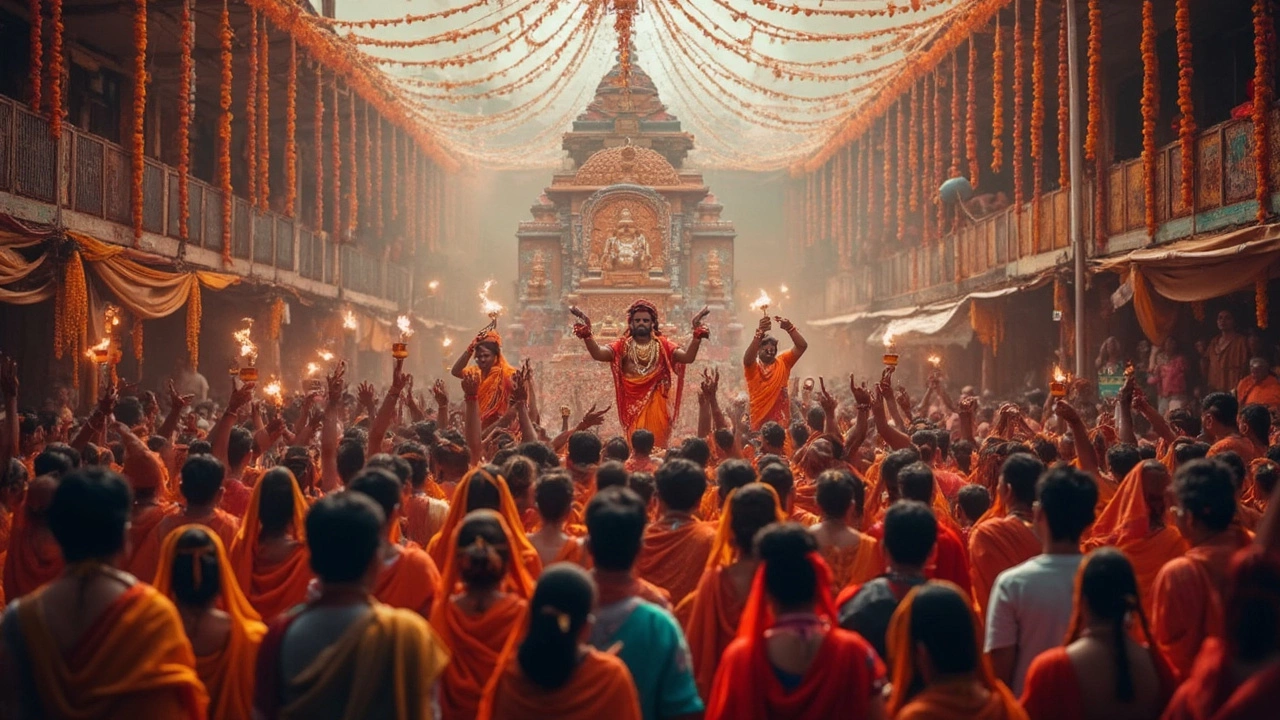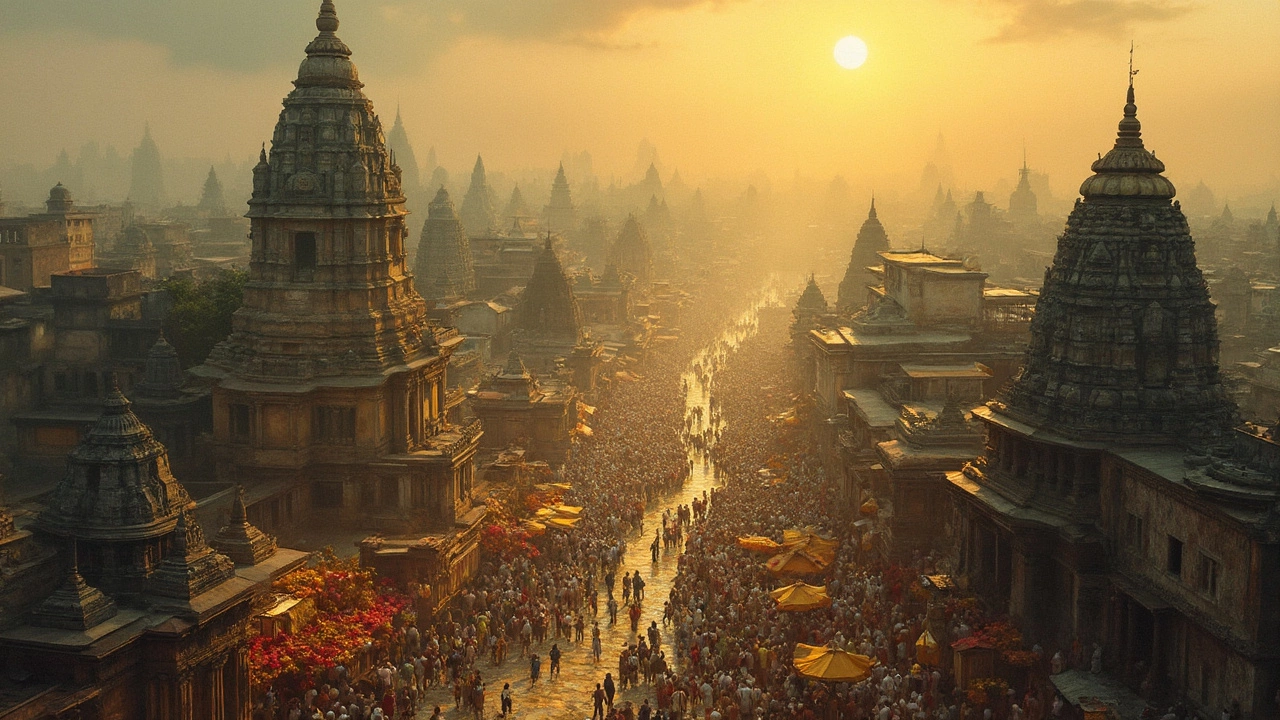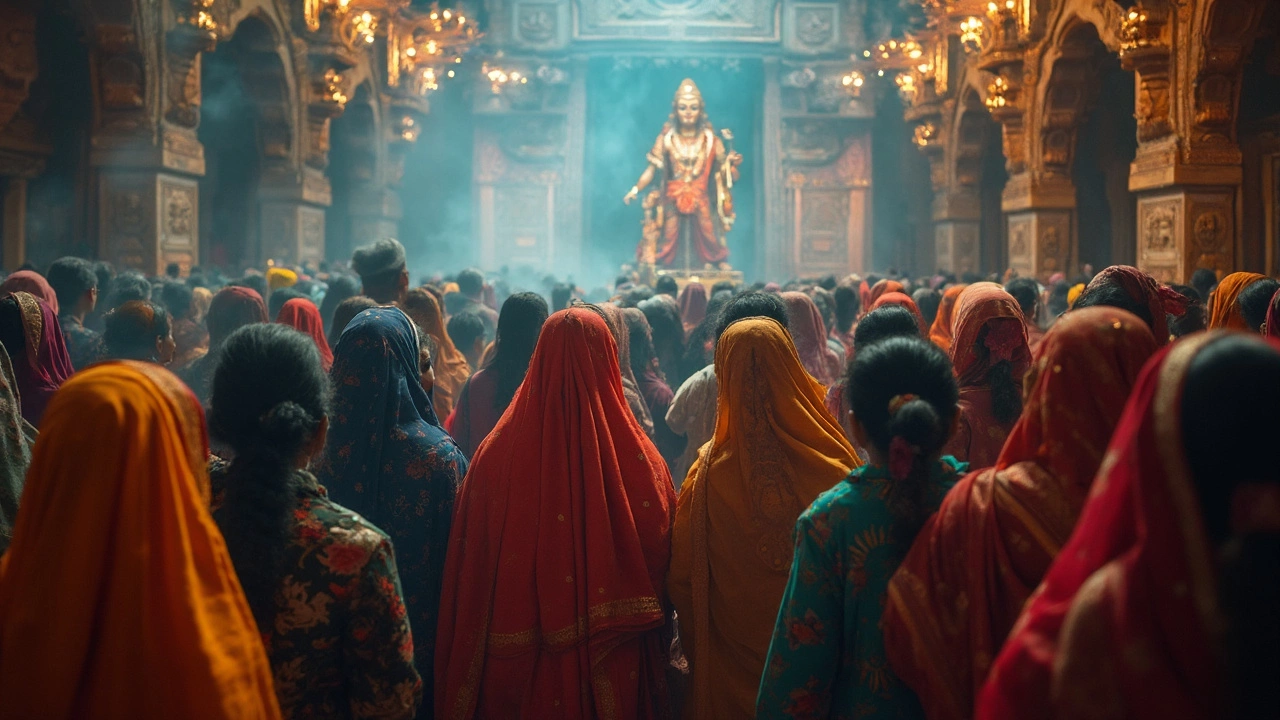Which God Has the Most Devotees in India? A Closer Look
 May, 3 2025
May, 3 2025
If you ask ten people in India about the most worshipped god, you'll probably get ten different answers—and a heated debate. But if we look at sheer numbers, the stats say Lord Vishnu in his many forms (think Krishna and Rama) pulls in the biggest crowd. How do we know? The lines at places like Tirupati Balaji, which gets more visitors than the Vatican or Mecca most years, tell the story. During the festival season, you can see hundreds of thousands of people lining up for a glimpse of the idol, with some folks making the trip every single year.
It’s not just about religious texts or what your grandparents say—it’s about seeing the crowds at these famous temples and checking real visitor records. People often travel hundreds of kilometers just to stand for a minute in front of their chosen god. Knowing which temples attract the biggest crowds can actually make or break your trip plans. If you’re thinking about temple tours, it helps to know where the major action happens, which times to avoid long lines, and what makes these spots tick.
- Why Numbers Matter: The Big Picture
- The Top Contenders: Krishna, Shiva, Vishnu, and Devi
- Crowd Magnets: Temples That Never Sleep
- What Drives Devotion? Festivals, Personal Beliefs, and Regional Loyalty
- Tips for Making the Most of Your Temple Tour
Why Numbers Matter: The Big Picture
Ever stood in a sweaty temple line for hours and wondered, "Just how many people come here every year?" The numbers aren’t just trivia—they tell you which temple towns really pack in the crowds, and where local economies boom around faith. Knowing which most devotees god India draws the feverish turnout helps you plan, skip the jams, and maybe even join in when it counts most.
Here’s what the numbers reveal: the Tirupati Balaji temple in Andhra Pradesh sees a whopping 50,000 to 100,000 pilgrims on regular days. These figures can rocket up to 500,000 people during major festivals. That’s not just the highest for Hindu temples—it's one of the highest for any religious site worldwide. And it’s Lord Vishnu, worshipped there as Venkateswara, who is at the center of all this action.
Take a look at how temple visitor counts stack up:
| Temple Name | Main Deity | Average Daily Visitors |
|---|---|---|
| Tirupati Balaji | Vishnu (Venkateswara) | 50,000-100,000 |
| Vaishno Devi | Devi | 30,000-50,000 |
| Sai Baba, Shirdi | Sai Baba | 25,000-50,000 |
| Kashi Vishwanath | Shiva | 10,000-20,000 |
Why do these numbers matter to travelers? Big numbers mean big lines, so timing your visit right can save hours. Extra crowds mean more energy, but also more pickpockets and packed hotels—no sugarcoating it. If you want an experience that matches the buzz seen on TV or social media, hit these temples during major festivals. For a quieter trip, go mid-week or offseason. Either way, understanding the big picture in Indian faith—who’s worshipped and where—turns a random trip into something way more memorable and hassle-free.
The Top Contenders: Krishna, Shiva, Vishnu, and Devi
If you look at popular temples or crowd photos around festival season, the top gods people talk about are Lord Krishna, Lord Shiva, Lord Vishnu, and the goddess Devi (also called Shakti or Durga in some regions). Each has their own fan clubs—giant ones at that—but not all have the same number of regular devotees or temple visitors.
Let’s get specific. Lord Vishnu, especially in his avatar as Venkateswara (Tirupati Balaji), sets records for most devotees god India. The Tirumala Tirupati Devasthanam pulls in close to 50,000 to 100,000 visitors a day, not even counting the special festival rush. During Brahmotsavam, that number can jump to half a million daily. It's not just about numbers—there’s an entire economy and ecosystem running around this one temple town.
Lord Shiva is no slouch either. If you’ve ever seen the crowd on Mahashivaratri at Kashi Vishwanath or Kedarnath, you’ll get it. Shiva temples are everywhere, from small shrines to major pilgrimage circuits like the 12 Jyotirlingas. The Kashi Vishwanath temple alone gets millions of visitors a year—especially during Sawan.
Now, Krishna shrines are a different story. Mathura and Vrindavan, his main stomping grounds, fill up during Janmashtami, with hundreds of thousands pouring in. ISKCON temples around the world also spread his fan club far and wide. In the south, Guruvayur in Kerala is where you’ll find crowds lining up for hours, especially during big temple festivals.
Devi or Shakti, in her forms like Durga, Kali, or Vaishno Devi, inspires massive devotion all across North and East India. Vaishno Devi temple alone sees over 8 million pilgrims yearly, according to official stats. During Navratri, Durga temples in West Bengal and Gujarat see endless lines of worshippers, and sometimes the rush gets so intense they have crowd-control teams just to avoid accidents.
Here’s a quick table showing typical yearly visitor figures to drive the point home:
| Temple | Main Deity | Annual Visitors |
|---|---|---|
| Tirupati Balaji | Vishnu (Venkateswara) | 30-40 million |
| Kashi Vishwanath | Shiva | 8-10 million |
| Vaishno Devi | Devi (Shakti) | 8-9 million |
| Guruvayur | Krishna | 5-7 million |
Each of these deities has millions of devotees who keep the temple tours circuit busy all year. The crowds don’t lie—the popularity contest is real, and numbers say Vishnu’s avatars, especially at popular temples like Tirupati, currently lead the pack.

Crowd Magnets: Temples That Never Sleep
Step inside some of India’s famous temples and you’ll get why they’re called crowd magnets. These places aren’t just busy during festivals—they’re packed round the clock, every day. The most jaw-dropping example is the Tirupati Balaji temple in Andhra Pradesh. It sees up to 50,000 visitors a day on regular weekdays. During festivals like Brahmotsavam, it can hit over 500,000. No kidding—lines can snake for kilometers, and tickets for a quick express darshan sell out days ahead.
Another superstar is Vaishno Devi in Jammu. Pilgrims climb 13 kilometers up a mountain, day and night, to reach the cave shrine. Even heavy rain or snow doesn’t stop them. According to the temple board, over 8 million people visit Vaishno Devi every year. Ramadan, Christmas—doesn’t matter, there’s always a crowd. It gets so packed that helicopter rides are now offered as a faster alternative for devotees who can’t make the climb.
Shirdi Sai Baba temple in Maharashtra is another non-stop hub. No matter when you drop by—even at odd hours—you’ll spot families, tourists, and even celebrities in line. In 2023, Shirdi recorded close to 20 million visitors throughout the year, according to Maharashtra’s tourism report.
“Tirupati sets a global benchmark. The crowd management at this temple is studied by authorities running big events worldwide.” – The Hindu, 2024
To give a quick lowdown, here’s how these Hindu temples stack up against some of the world’s busiest centers:
| Temple | State | Annual Visitors (Approx.) |
|---|---|---|
| Tirupati Balaji | Andhra Pradesh | 35 million |
| Vaishno Devi | Jammu & Kashmir | 8 million |
| Shirdi Sai Baba | Maharashtra | 20 million |
If you’re planning a visit, keep an eye on festival dates and book tickets early. Don’t expect peace and quiet here—expect excitement, non-stop activity, and a real-life show of faith. These temples aren’t just popular in the books—they’re action-packed in real life, 24/7.
What Drives Devotion? Festivals, Personal Beliefs, and Regional Loyalty
Why do some gods have millions waiting for hours, while others see smaller gatherings? In India, devotion isn’t just about tradition. A big chunk of it comes from how people connect emotionally, celebrate festivals, and stick to their roots.
Festivals are a massive pull. For instance, Janmashtami (Krishna’s birthday) and Ram Navami (celebrating Lord Rama) turn cities like Mathura and Ayodhya into buzzing hubs. People of all ages crowd temples, sometimes increasing the footfall by ten times compared to regular days. During Diwali, towns dedicated to Lord Vishnu and his avatars light up for miles. To put it in numbers, Tirupati Balaji temple can see over 300,000 visitors within a festival week—as much as a year’s worth of tourists for some international landmarks.
But it’s not just festival frenzy. Personal beliefs matter a lot. Some families have been worshipping Hinduism gods like Krishna or Shiva for generations. For example, whole villages in Tamil Nadu might see Lord Murugan (an avatar of Shiva) as their protector, while folks in Odisha won’t miss the Jagannath Rath Yatra for anything, even traveling back from big cities for it.
Regional loyalty is another huge part. The god with the most devotees in India can actually change depending on where you are. For example:
- Northern India: Lots of focus on Rama and Krishna temples.
- South India: Vishnu in the form of Venkateswara or Shiva grabs attention, with temples like Tirupati and Rameshwaram overflowing during special days.
- West Bengal and Assam: It’s the goddess Durga who’s the center of devotion, especially during Durga Puja.
If you’re planning on catching a temple tour during a big festival, check local calendars. Trains and hotels fill up fast, and temples might have special routes or extra timings for the crowd. Locals often know faster ways in or quieter hours late at night or early morning when the rush dies down.
Here’s a quick look at temple footfall during peak festivals:
| Temple | Main Festival | Average Daily Visitors (festival week) |
|---|---|---|
| Tirupati Balaji | Brahmotsavam | 300,000+ |
| Vaishno Devi | Navratri | 150,000+ |
| Jagannath, Puri | Rath Yatra | 200,000+ |
| Siddhivinayak, Mumbai | Ganesh Chaturthi | 100,000+ |
So, what drives such devotion? It’s this wild mix of big festivals, old family traditions, and strong local pride—each one adding another layer to India’s never-ending temple crowds.

Tips for Making the Most of Your Temple Tour
If you’re planning a trip to see India’s famous temples and find out which god has the most devotees in India, a little planning will save you time—and stress. With millions visiting spots like Tirupati Balaji and Shirdi every year, you’ll want a game plan to avoid endless lines and make your visit count.
- Visit Off-Peak: If you’re not going for a big festival tied to Indian deities, try to avoid weekends and holidays. Weekdays or early mornings are your best bet. Temples like Meenakshi in Madurai and Jagannath Puri are less crowded after noon when the rush slows down, and darshan (viewing the deity) is easier.
- Book Tickets Ahead: Many popular places like Tirupati and Vaishno Devi now offer online booking for darshan slots or ‘special entry’ tickets. This helps you skip the general queue—which can stretch for hours.
- Dress Right: Most temples have strict dress codes. At Padmanabhaswamy in Kerala, men are required to wear a mundu, and women need to wear a sari or full-length skirt. Always check ahead, so you don’t get turned away at the door.
- Pack Light and Smart: Large bags, shoes, belts, and electronics are usually not allowed inside main temple premises. Most temples have a cloakroom, but leaving valuables at your hotel is much safer.
- Pay Attention to Temple Timings: Many temples close for a few hours in the afternoon for rituals and cleaning. Always check the official website or local boards to avoid waiting outside in the heat.
- Respect Rituals and Rules: Always follow signs, and don’t enter areas marked as restricted. At temples like Kashi Vishwanath and Somnath, some zones are only open to Hindus, and security is tight.
| Temple | City/State | Estimated Visitors/Day |
|---|---|---|
| Tirumala Venkateswara | Tirupati, Andhra Pradesh | 50,000–100,000 |
| Shirdi Sai Baba | Shirdi, Maharashtra | 25,000–50,000 |
| Vaishno Devi | Katra, Jammu & Kashmir | 30,000–40,000 |
Bringing a local guide, even just for the main temple, helps if you want to understand rituals or get good spots for darshan. Finally, always stay hydrated and wear comfortable shoes—you might end up walking and waiting more than you expect at these popular temples.